Contents
While Scotland is consistently beautiful, its weather is always unpredictable. You could experience all four seasons within one day, so no matter when you visit, be sure to pack for every type of weather. Layers (and rain gear) will be your best friends while on a Scottish holiday.
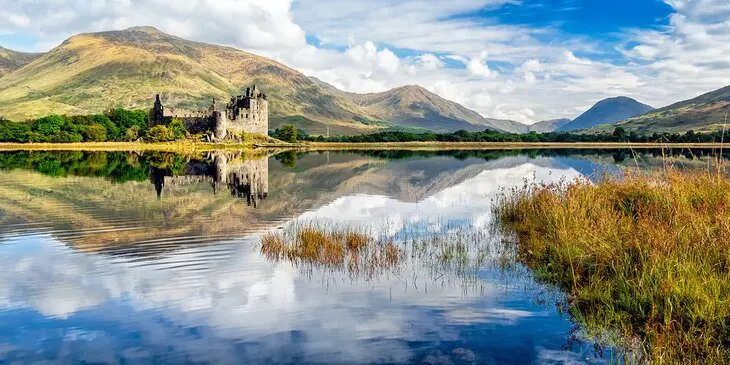
Due to its erratic climate, choosing when to visit Scotland will depend on what you want to do while you’re here. Whether you’re a lover of action-packed holidays or a fan of low-key vacations filled with culture, appropriate weather will help you make the most of your Scottish vacay.
Are you hoping to ski? Aim to arrive during late November or early December through March. Want to hit one of the famous Highland Festivals? Those happen in August.
Overall, the best time of year to travel to Scotland is during the spring or autumn, when you’ll be able to get outside (while wearing waterproofs), evade pesky bugs, and avoid the massive crowds that arrive during summer.
To help better plan your trip, here’s everything you need to know about the best time to visit Scotland.
On This Page:
- Best Time of Year to Visit Scotland
- Best Month to Visit Scotland
- Best Time to Visit Scotland Weather Wise
- Best Time to Visit the Scottish Highlands
- Best Time to Visit the Isle of Skye
- Best Time to Visit Edinburgh
- Cheapest Time to Visit Scotland
Best Time of Year to Visit Scotland
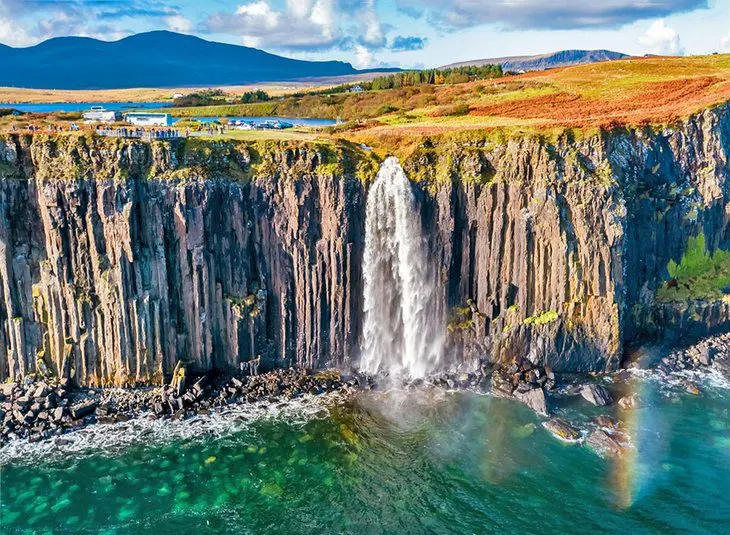
No matter when you visit Scotland, prepare to get wet. It rains a LOT here! The upside of all this moisture can be found in the lush and vibrant hills, bright green grasses, and beautiful spring blossoms.
If you’re hoping to enjoy more comfortable temperatures and a little break in all that precipitation, the best time of year to visit Scotland is during the spring (late March through June) or Autumn (September through November). April is the driest month, so keep that in mind if you’re hoping to explore without having to change shoes and socks.
Visiting during this time ensures you won’t shiver as much as you would during frigid December and January. It also helps you avoid the busier (and much pricier) high season (a.k.a. June, July, and August), with its tour buses crowding the most charming small towns and inns that are packed to capacity.
You’ll miss the jam-packed summer festivals like the Edinburgh International Festival, the Edinburgh Fringe Festival, and the Highland Games. And you won’t be able to watch the whales migrate, but you will be mesmerized by Scotland’s natural beauty bursting onto the scene in the form of buds, blossoms, and fall foliage. Plus, you’ll be able to experience it all in a quieter, more tranquil setting.
Another bonus: attractions that close mid-October have reopened by late-March, and those that enforced reduced hours during the colder, darker months are back up and running at full throttle.
If you’re worried about hitting cooler temperatures by avoiding summer travel, keep in mind that July and August only reach highs of 66 degrees Fahrenheit, so it’s not like you’re going to be sweating it out on a beach.
Best Month to Visit Scotland

June is the best month to visit Scotland. Most kids are still in school, which means you’ll have less tourists to contend with than you will once July and August hit. June also presents visitors with an ideal climate – highs reach the low 60s Fahrenheit and lows drop to the high 40s. As for rain, you’ll notice a smattering, and most days will be peppered by drops, but you shouldn’t have any torrential downfalls to contend with.
Technically, June is the start of high season, so you may notice an extra “0” or two after some hotel prices, but you can still score great deals by booking early. In terms of things to do in Scotland, all attractions are open with regular hours at this point, and festival season is ramping up. If you time your visit right, you can catch the Edinburgh International Film Festival, Glasgow International Jazz Festival, and Leith Festival this month.
Another plus: you’ll notice longer daylight hours in June, especially if you’re heading toward Lerwick (in the Shetland Islands), which boasts four more hours of sunlight than London has at this time of year. On the summer solstice (June 20th), Lerwick has 13 hours and six minutes more daylight than it did on the winter solstice (December 21st).
Best Time to Visit Scotland Weather Wise

Scotland is known for its unpredictable weather and penchant for gray, gloomy, wet skies. They’re so used to the dark, dreary days that the Scottish have coined a term to describe them. “Dreich” literally means dreary. Its synonyms include bleak, cheerless, chill, and cloudy. That’s not to say you won’t get a great day (or few hours) in this magical land, but it does mean you should do a bit of research to decide when you’re more likely to win the weather lottery.
The best time to visit Scotland weather wise is between May and September. The stinging winter winds have died down, leaving warmer, drier conditions in their wake. The days are becoming brighter, with mid-summer experiencing the longest days in Britain (winter, on the other hand, sees as little as seven hours of light each day).
Temperatures in May hover around the 50s, increasing to the high 60s by August. This is perfect weather for heading to one of Scotland’s most glorious beaches. From family-friendly resort towns built around their beaches to remote, sandy corners hidden in the nooks and crannies of the coast, you’ll love spending time by the Scottish shore in summer. Always bring a warm change of clothes, though, as you’re bound to get chilly after a dip in the cold water.
As for rain, you’re still going to feel it, but you’ll have fewer wet days at this time of year than you will during the late fall and winter.
One downside to visiting during July and August comes in the form of tiny, biting insects called midges. These easily inhaled bugs swarm every crevice, waiting to take a nip. Be sure to pack bug spray along with your rain gear. They’re especially bad on the west coast.
September is especially lovely, with mild temps in the mid to high 60s and less bugs to invade your space. This is a perfect time to visit the Orkney and Shetland Islands, which are often drier at this time of year than the mainland.
October is Scotland’s rainiest month, but also boasts the most beautiful display of orange, amber, gold, and green-hued heather blanketing the countryside. With highs in the mid-50s Fahrenheit, it’s a comfortable time to explore the outdoors, plus you won’t have to fight away those pesky midges. The sun is low at this time of year, presenting the most spectacular, long sunsets.
Best Time to Visit the Scottish Highlands

Most travelers visit the Highlands in hopes of traipsing through endless fields, climbing craggy cliffs, or conquering rolling hills. Their reward? Unbeatable views of the country’s lushest, most beautiful landscapes. With this in mind, the best time to visit the Scottish Highlands is between May and August.
These months present visitors with a comfortable climate. Being so far north, you don’t run the risk of being too hot. This is Scotland, though, so you never really run the risk of overheating – even August doesn’t raise the barometer past 70 degrees Fahrenheit.
Expect crowds and a higher bill during these months, which are considered high season for this region, especially when the uber-popular Highland Games are on offer. The region’s biggest event of this kind, the Cowal Highland Gathering, is held in Dunoon, Argyll (in the western Highlands) during late August. From witnessing highland dancing competitions to pipe band performances to shot-putt events, and caber tosses, you really won’t want to miss this!
Unless you’re an avid skier, avoid traveling to the Highlands during the winter months. At this time, many of the area’s trails will be closed (or aren’t easily accessed) due to snow or fog, which can limit your ability to explore. Some of the region’s hotels also close during this time, as do local businesses.
Those hoping to ski, though, will enjoy traveling during December through February. The ski resorts are open, and fresh powder graces many of the runs.
Best Time to Visit the Isle of Skye
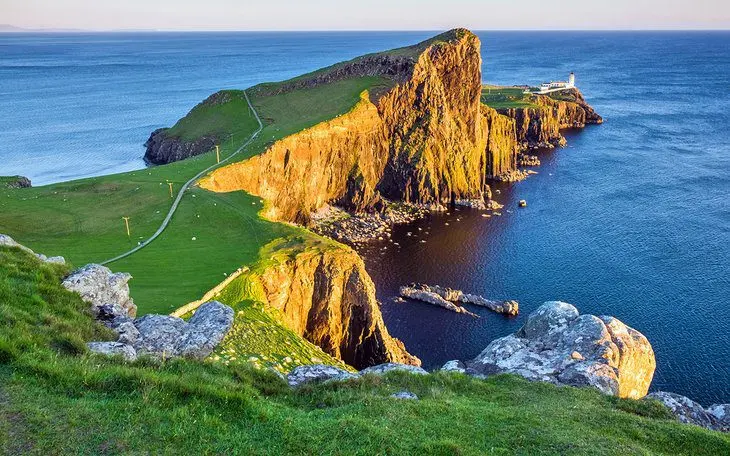
The Isle of Skye is home to some of the UK’s most magnificent landscapes. From cascading waterfalls to magical fairy glens to lush mountains, this 80-kilometer-long wonderland is worth a visit in any season. If you’re hoping to get the most out of your holiday, though, the best time to visit the Isle of Skye is between May and July.
Late spring offers visitors moderate temperatures (expect lows in the high 40s degrees Fahrenheit and highs up to 60) and a moderate amount of rain – between 11 and 14 days each month are hit with significant amounts of precipitation. This sounds like a lot of damp, but we’re talking about Scotland here. It rains pretty much ALL the time. To put things into perspective, June actually experiences the least amount of rain and snow. You’ll need waterproofs for sure if exploring Scotland during these months and warm layers are another must.
Can’t make it during spring? Time your visit between October and March to garner a great deal. Be prepared for colder weather (the winter is humid and cool, with highs of only 39 degrees Fahrenheit in January). This is also the rainiest (or snowiest) time to visit.
October is the wettest month, with up to 152 millimeters of rain. The upside, though, are fewer tourists (with the exception of the Christmas holiday rush) and lower prices (again, outside the holiday period). Some of the Isle of Skye’s most popular attractions, though, may close early (or entirely) during these months.
Why not visit the Isle of Skye during the summer, you ask. It’s true, July and August are warmer than the spring months. That said, the highs are only going to hit about 65 degrees Fahrenheit, so if you’re hoping for balmy, you’ll need to look elsewhere.
Plus, the summer is still prone to rain (between 9 and 15 days of it occur each month), and this season attracts the highest number of tourists. This means two things: 1. You’ll be waiting much longer to take a photo free of people marring the background and 2. You’ll be facing the highest prices for hotels and attractions. If you don’t mind those odds, head out during summer vacay and enjoy the less chilly days.
Best Time to Visit Edinburgh

Hoping to spend some time in Scotland’s magnificent capital? Great idea! Edinburgh is crowned by the iconic Edinburgh Castle. Perched high above the Firth of Forth, this historic marvel is hard to miss. Packed with charming townhouses, cobblestone streets, eclectic shops, and fantastic eateries, there’s a ton of things to see and do in this gorgeous city.
To get the most out of your visit, the best time to visit Edinburgh is between May and September. These months offer the best weather (think: less rain, higher temperatures, and longer hours of sunlight). If you want to avoid getting soaked, May stays the driest. May through September also offers more entertainment than other times of the year, and these months play host to a lot more people.
If you’re hoping to see Edinburgh at its busiest and most vibrant, be sure to visit during July and/or August. You’ll have to book a hotel room well in advance (we’d suggest up to a year before your travel date) and expect to dole out extra cash for everything from dinner to your room.
August hosts the popular Edinburgh Fringe Festival, Edinburgh International Festival, and the Edinburgh Military Tattoo, three extremely different, highly entertaining events you won’t want to miss.
Cheapest Time to Visit Scotland
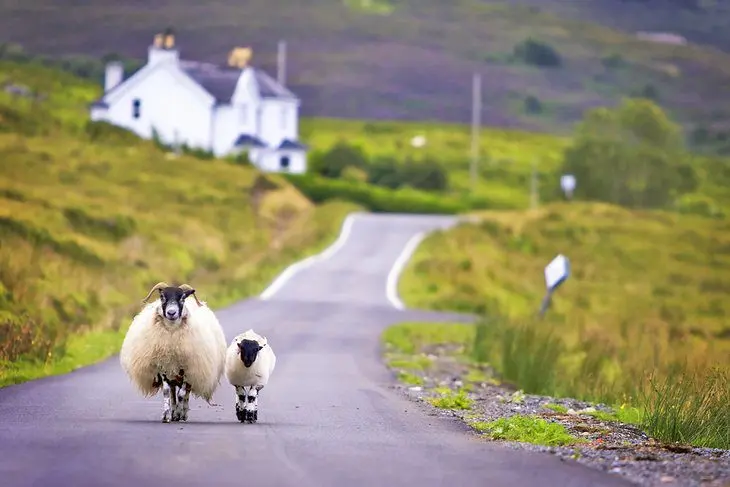
No vacation is cheap, especially when you’re visiting the UK (that pound to dollar conversion rarely works in our favor). Luckily, there are a few ways that you can lower your costs for a Scottish holiday. The main one is by being creative with your timing.
The cheapest time to visit Scotland is between November and December and again from late December through mid-March. Considered the area’s low season, the temperatures drop, along with the number of visitors. That means you’ll be more likely to score a good deal on a hotel room, and you won’t have to elbow your way into Glasgow or Edinburgh’s top museums.
Since less people travel to Scotland during these months, you’ll be more likely to find cheap flights, especially during the week. You’ll also be more likely to get soaked, but that won’t matter so much while you’re enjoying a super cheap private tour though the Highlands.
Plus, as long as you’re prepared for the inevitable weather changes and unfavorable temps, you’ll be happy to find other ways to spend all that cash you saved (like buying Celtic jewelry, wool sweaters, tartans, and maybe a kilt or two).
Just because you’re traveling at the cheapest time doesn’t mean you won’t find a bunch of fun things to do. Scotland is a beauty in all seasons, and winter’s dusting of snow and frost added to dark and misty days can add to the magical allure of this gorgeous Isle. Whether you’re hoping to ski in the Nevis mountain range, shop in a Christmas market in Edinburgh, or go dogsledding in Cairngorm National Park, there are plenty of interesting places to visit in Scotland in winter.
More Related Articles on PlanetWare.com
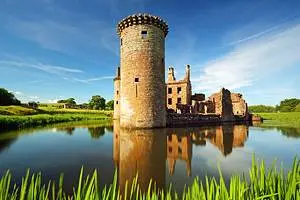
Get to Know Scotland: Now that you know when to visit this magical spot, it’s time to figure out where to spend your time while in Scotland. From visiting Edinburgh’s iconic castle to climbing Ben Nevis, these fun tourist attractions should be on every to-do list. While you’re at it, take a gander at these impressive (and unmissable) places to visit, which include the gorgeous Scottish Highlands.

Uncover Scotland’s Heart: Scotland’s charming small towns are perhaps its greatest asset (if you ignore the dramatic landscapes, that is). This is where you’ll meet “salt of the earth” locals, who’ll entrance you with their stories, fast friendship, and delectable dishes. When the weather clears, why not head to Oban. A busy West Coast town, this pretty spot lies in a sheltered bay and is a popular base for sightseeing in the Highlands.









